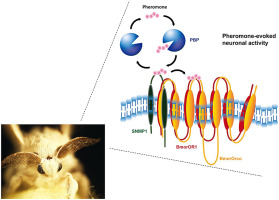当前位置:
X-MOL 学术
›
Insect Biochem. Mol. Biol.
›
论文详情
Our official English website, www.x-mol.net, welcomes your feedback! (Note: you will need to create a separate account there.)
A phylogenomics approach to characterizing sensory neuron membrane proteins (SNMPs) in Lepidoptera.
Insect Biochemistry and Molecular Biology ( IF 3.8 ) Pub Date : 2020-01-03 , DOI: 10.1016/j.ibmb.2020.103313 Hui-Jie Zhang 1 , Wei Xu 2 , Quan-Mei Chen 3 , Le-Na Sun 3 , Alisha Anderson 4 , Qing-You Xia 3 , Alexie Papanicolaou 5
Insect Biochemistry and Molecular Biology ( IF 3.8 ) Pub Date : 2020-01-03 , DOI: 10.1016/j.ibmb.2020.103313 Hui-Jie Zhang 1 , Wei Xu 2 , Quan-Mei Chen 3 , Le-Na Sun 3 , Alisha Anderson 4 , Qing-You Xia 3 , Alexie Papanicolaou 5
Affiliation

|
Sensory neuron membrane proteins (SNMPs) play a critical role in the insect olfactory system but there is a deficit of functional studies beyond Drosophila. Here, we use a combination of available genome sequences, manual curation, genome and transcriptome data, phylogenetics, expression profiling and gene knockdown to investigate SNMP superfamily in various insect species with a focus on Lepidoptera. We curated 81 genes from 36 insect species and identified a novel lepidopteran SNMP gene family, SNMP3. Phylogenetic analysis shows that lepidopteran SNMP3, but not the previously annotated lepidopteran SNMP2, is the true homologue of the dipteran SNMP2. Digital expression, microarray and qPCR analyses show that the lepidopteran SNMP1 is specifically expressed in adult antennae. SNMP2 is widely expressed in multiple tissues while SNMP3 is specifically expressed in the larval midgut. Microarray analysis suggest SNMP3 may be involved in the silkworm immunity response to virus and bacterial infections. We functionally characterized SNMP1 in the silkworm using RNA interference (RNAi) and behavioral assays. Our results suggested that Bombyx mori SNMP1 is a functional orthologue of the Drosophila melanogaster SNMP1 and plays a critical role in pheromone detection. Split-ubiquitin yeast hybridization study shows that BmorSNMP1 has a protein-protein interaction with the pheromone receptor (BmorOR1), and the co-receptor (BmorOrco). Concluding, we propose a novel molecular model in which BmorOrco, BmorSNMP1 and BmorOR1 form a heteromer in the detection of the silkworm sex pheromone bombykol.
中文翻译:

系统发育组学方法表征鳞翅目中的感觉神经元膜蛋白(SNMPs)。
感觉神经元膜蛋白(SNMPs)在昆虫的嗅觉系统中起着至关重要的作用,但果蝇以外的功能研究还很不足。在这里,我们结合可用的基因组序列,手动管理,基因组和转录组数据,系统发育,表达谱和基因敲低的组合,研究鳞翅目昆虫在各种昆虫中的SNMP超家族。我们从36个昆虫物种中选出81个基因,并鉴定了新的鳞翅目SNMP基因家族SNMP3。系统发育分析表明鳞翅目SNMP3,而不是先前注释的鳞翅目SNMP2,是双翅目SNMP2的真正同源物。数字表达,微阵列和qPCR分析表明鳞翅目SNMP1在成虫触角中特异性表达。SNMP2在多种组织中广泛表达,而SNMP3在幼虫中肠中特别表达。基因芯片分析表明,SNMP3可能参与家蚕对病毒和细菌感染的免疫反应。我们使用RNA干扰(RNAi)和行为分析对蚕中的SNMP1进行功能鉴定。我们的结果表明,家蚕SNMP1是果蝇SNMP1的功能直系同源物,并且在信息素检测中起关键作用。分裂泛素酵母杂交研究表明,BmorSNMP1与信息素受体(BmorOR1)和共受体(BmorOrco)具有蛋白质相互作用。最后,我们提出了一种新型分子模型,其中BmorOrco,BmorSNMP1和BmorOR1在检测家蚕性信息素bombykol中形成了一个异源单体。基因芯片分析表明,SNMP3可能参与家蚕对病毒和细菌感染的免疫反应。我们使用RNA干扰(RNAi)和行为分析对蚕中的SNMP1进行功能鉴定。我们的结果表明,家蚕SNMP1是果蝇SNMP1的功能直系同源物,并且在信息素检测中起关键作用。分裂泛素酵母杂交研究表明,BmorSNMP1与信息素受体(BmorOR1)和共受体(BmorOrco)具有蛋白质相互作用。最后,我们提出了一种新型分子模型,其中BmorOrco,BmorSNMP1和BmorOR1在检测家蚕性信息素bombykol中形成了一个异源单体。基因芯片分析表明,SNMP3可能参与家蚕对病毒和细菌感染的免疫反应。我们使用RNA干扰(RNAi)和行为分析对蚕中的SNMP1进行功能鉴定。我们的结果表明,家蚕SNMP1是果蝇SNMP1的功能直系同源物,并且在信息素检测中起关键作用。分裂泛素酵母杂交研究表明,BmorSNMP1与信息素受体(BmorOR1)和共受体(BmorOrco)具有蛋白质相互作用。最后,我们提出了一种新型分子模型,其中BmorOrco,BmorSNMP1和BmorOR1在检测家蚕性信息素bombykol中形成了一个异源单体。我们使用RNA干扰(RNAi)和行为分析对蚕中的SNMP1进行功能鉴定。我们的结果表明,家蚕SNMP1是果蝇SNMP1的功能直系同源物,并且在信息素检测中起关键作用。分裂泛素酵母杂交研究表明,BmorSNMP1与信息素受体(BmorOR1)和共受体(BmorOrco)具有蛋白质相互作用。最后,我们提出了一种新型分子模型,其中BmorOrco,BmorSNMP1和BmorOR1在检测家蚕性信息素bombykol中形成了一个异源单体。我们使用RNA干扰(RNAi)和行为分析对蚕中的SNMP1进行功能鉴定。我们的结果表明,家蚕SNMP1是果蝇SNMP1的功能直系同源物,并且在信息素检测中起关键作用。分裂泛素酵母杂交研究表明,BmorSNMP1与信息素受体(BmorOR1)和共受体(BmorOrco)具有蛋白质相互作用。最后,我们提出了一种新型分子模型,其中BmorOrco,BmorSNMP1和BmorOR1在检测家蚕性信息素bombykol中形成了一个异源单体。分裂泛素酵母杂交研究表明,BmorSNMP1与信息素受体(BmorOR1)和共受体(BmorOrco)具有蛋白质相互作用。最后,我们提出了一种新型分子模型,其中BmorOrco,BmorSNMP1和BmorOR1在检测家蚕性信息素bombykol中形成了一个异源单体。分裂泛素酵母杂交研究表明,BmorSNMP1与信息素受体(BmorOR1)和共受体(BmorOrco)具有蛋白质相互作用。最后,我们提出了一种新型分子模型,其中BmorOrco,BmorSNMP1和BmorOR1在检测家蚕性信息素bombykol中形成了一个异源单体。
更新日期:2020-01-04
中文翻译:

系统发育组学方法表征鳞翅目中的感觉神经元膜蛋白(SNMPs)。
感觉神经元膜蛋白(SNMPs)在昆虫的嗅觉系统中起着至关重要的作用,但果蝇以外的功能研究还很不足。在这里,我们结合可用的基因组序列,手动管理,基因组和转录组数据,系统发育,表达谱和基因敲低的组合,研究鳞翅目昆虫在各种昆虫中的SNMP超家族。我们从36个昆虫物种中选出81个基因,并鉴定了新的鳞翅目SNMP基因家族SNMP3。系统发育分析表明鳞翅目SNMP3,而不是先前注释的鳞翅目SNMP2,是双翅目SNMP2的真正同源物。数字表达,微阵列和qPCR分析表明鳞翅目SNMP1在成虫触角中特异性表达。SNMP2在多种组织中广泛表达,而SNMP3在幼虫中肠中特别表达。基因芯片分析表明,SNMP3可能参与家蚕对病毒和细菌感染的免疫反应。我们使用RNA干扰(RNAi)和行为分析对蚕中的SNMP1进行功能鉴定。我们的结果表明,家蚕SNMP1是果蝇SNMP1的功能直系同源物,并且在信息素检测中起关键作用。分裂泛素酵母杂交研究表明,BmorSNMP1与信息素受体(BmorOR1)和共受体(BmorOrco)具有蛋白质相互作用。最后,我们提出了一种新型分子模型,其中BmorOrco,BmorSNMP1和BmorOR1在检测家蚕性信息素bombykol中形成了一个异源单体。基因芯片分析表明,SNMP3可能参与家蚕对病毒和细菌感染的免疫反应。我们使用RNA干扰(RNAi)和行为分析对蚕中的SNMP1进行功能鉴定。我们的结果表明,家蚕SNMP1是果蝇SNMP1的功能直系同源物,并且在信息素检测中起关键作用。分裂泛素酵母杂交研究表明,BmorSNMP1与信息素受体(BmorOR1)和共受体(BmorOrco)具有蛋白质相互作用。最后,我们提出了一种新型分子模型,其中BmorOrco,BmorSNMP1和BmorOR1在检测家蚕性信息素bombykol中形成了一个异源单体。基因芯片分析表明,SNMP3可能参与家蚕对病毒和细菌感染的免疫反应。我们使用RNA干扰(RNAi)和行为分析对蚕中的SNMP1进行功能鉴定。我们的结果表明,家蚕SNMP1是果蝇SNMP1的功能直系同源物,并且在信息素检测中起关键作用。分裂泛素酵母杂交研究表明,BmorSNMP1与信息素受体(BmorOR1)和共受体(BmorOrco)具有蛋白质相互作用。最后,我们提出了一种新型分子模型,其中BmorOrco,BmorSNMP1和BmorOR1在检测家蚕性信息素bombykol中形成了一个异源单体。我们使用RNA干扰(RNAi)和行为分析对蚕中的SNMP1进行功能鉴定。我们的结果表明,家蚕SNMP1是果蝇SNMP1的功能直系同源物,并且在信息素检测中起关键作用。分裂泛素酵母杂交研究表明,BmorSNMP1与信息素受体(BmorOR1)和共受体(BmorOrco)具有蛋白质相互作用。最后,我们提出了一种新型分子模型,其中BmorOrco,BmorSNMP1和BmorOR1在检测家蚕性信息素bombykol中形成了一个异源单体。我们使用RNA干扰(RNAi)和行为分析对蚕中的SNMP1进行功能鉴定。我们的结果表明,家蚕SNMP1是果蝇SNMP1的功能直系同源物,并且在信息素检测中起关键作用。分裂泛素酵母杂交研究表明,BmorSNMP1与信息素受体(BmorOR1)和共受体(BmorOrco)具有蛋白质相互作用。最后,我们提出了一种新型分子模型,其中BmorOrco,BmorSNMP1和BmorOR1在检测家蚕性信息素bombykol中形成了一个异源单体。分裂泛素酵母杂交研究表明,BmorSNMP1与信息素受体(BmorOR1)和共受体(BmorOrco)具有蛋白质相互作用。最后,我们提出了一种新型分子模型,其中BmorOrco,BmorSNMP1和BmorOR1在检测家蚕性信息素bombykol中形成了一个异源单体。分裂泛素酵母杂交研究表明,BmorSNMP1与信息素受体(BmorOR1)和共受体(BmorOrco)具有蛋白质相互作用。最后,我们提出了一种新型分子模型,其中BmorOrco,BmorSNMP1和BmorOR1在检测家蚕性信息素bombykol中形成了一个异源单体。



























 京公网安备 11010802027423号
京公网安备 11010802027423号